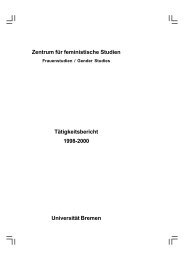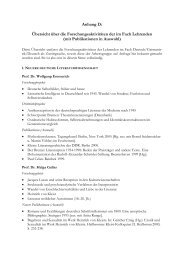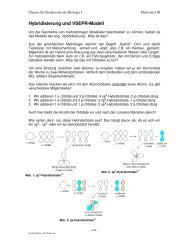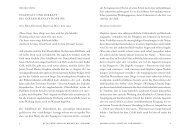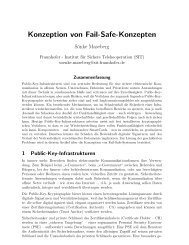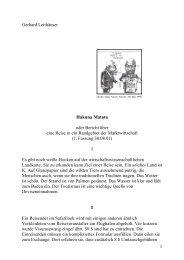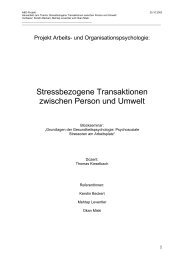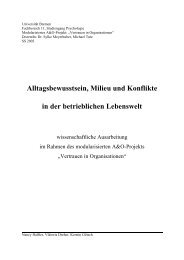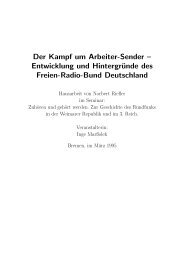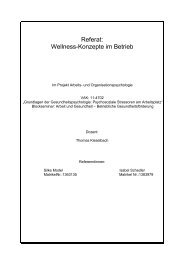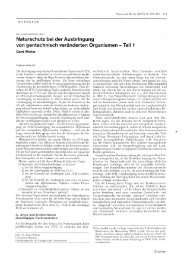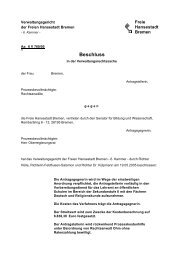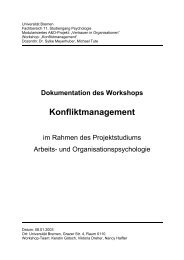Extending collostructional analysis - www-user
Extending collostructional analysis - www-user
Extending collostructional analysis - www-user
Create successful ePaper yourself
Turn your PDF publications into a flip-book with our unique Google optimized e-Paper software.
114 Stefan Th. Gries and Anatol Stefanowitsch<br />
Table 5. Collexemes distinguishing between the will and the be going to future<br />
Will (N=3,667) Be going to (N=980)<br />
Collexeme Distinctiveness Collexeme Distinctiveness<br />
see (90:8) 0.0004 say (28:42) 1.12E-12<br />
find (58:4) 0.0015 do (105:68) 2.02E-08<br />
give (69:7) 0.0047 happen (11:15) 4.77E-05<br />
know (34:2) 0.0108 have (126:61) 0.0001<br />
provide (17:0) 0.0177 go (96:48) 0.0004<br />
depend (15:0) 0.0285 win (1:6) 0.0005<br />
want (22:1) 0.0305 stay (8:10) 0.0014<br />
receive (14:0) 0.0361 use (19:14) 0.0045<br />
consider (13:0) 0.0458 buy (2:5) 0.0059<br />
remain (13:0) 0.0458 talk (16:11) 0.0160<br />
become (19:1) 0.0553 show (22:13) 0.0213<br />
finish (12:0) 0.0581 get (84:34) 0.0275<br />
hold (11:0) 0.0736 suggest (1:3) 0.0315<br />
include (11:0) 0.0736 be (664:203) 0.0357<br />
notice (11:0) 0.0736 put (19:11) 0.0362<br />
follow (10:0) 0.0934 invest (0:2) 0.0444<br />
reach (10:0) 0.0934 measure (0:2) 0.0444<br />
need (16:1) 0.0985 perform (0:2) 0.0444<br />
send (21:2) 0.1080 photocopy (0:2) 0.0444<br />
accept (9:0) 0.1184 rehearse (0:2) 0.0444<br />
than will (Thompson & Martinet 1986:185ff.; Murphy 1986:16), and, perhaps<br />
related to this point, (iii) be going to is used for talking about a more immediate<br />
future than will (Thompson & Martinet 1986:185; Murphy 1986:16). Clearly,<br />
none of these factors can straightforwardly be related to particular (semantic<br />
classes of) verbs, and thus they cannot be expected to show up transparently in<br />
the lists of distinctive collexemes. However, some reflex of these factors might<br />
be expected. Table 5 lists the results of the distinctive-collexeme <strong>analysis</strong>.<br />
The most striking difference between the two lists concerns the dynamicity<br />
of the actions and events encoded. The distinctive collexemes for will<br />
are overwhelmingly relatively non-agentive or low-dynamicity actions (find,<br />
receive, hold, finish, reach) including perception/cognition events (see, know,<br />
want, consider, notice, need, accept), or states (depend, remain, become). Only<br />
five of the top 20 collexemes encode dynamic actions (give, provide, include,<br />
follow, send). With be going to, the situation is reversed: only five of the top 20<br />
collexemes encode states or non-agentive actions (have, stay, be, happen, get);<br />
the other fifteen collexemes encode very dynamic actions. A second difference<br />
Uncorrected proofs - © John Benjamins Publishing Company



